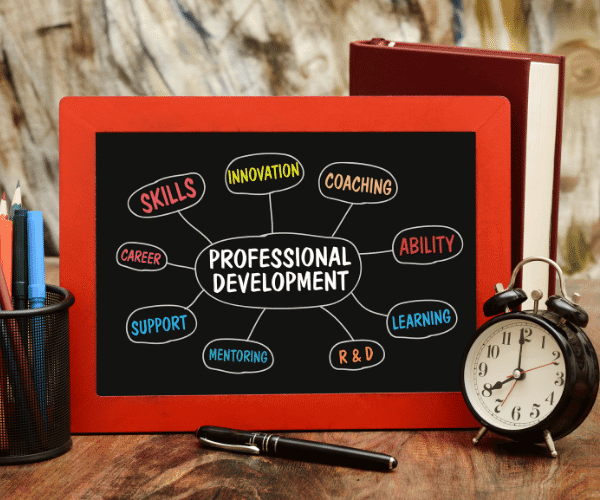We Made It Through 2021!
Teaching didn’t just become tough! COVID-19 only helped to magnify some of the challenges educators face. During the pandemic, the world has begun to recognize the contribution and spotlight the incredible responsibility that teachers bear in ensuring that all children and youth everywhere can enjoy the right to an education. Teachers go above and beyond for students daily. Educators worldwide use phrases like ‘We Made It’ whenever they have a break. You may hear them shout the phrase as they approach Thanksgiving, Winter Break, Spring Break, or simply the weekend! As we embark upon the ending of the year 2021, it seems appropriate to celebrate as this is the halfway point for educators. It signifies hope as teachers close the year and welcome a New Year!
Why are Educators so excited about these breaks? It’s simple; teachers feel more challenged than ever! Rand Corporation research shows that some of the top challenges include teachers helping students build meaningful relationships, balancing stress and dealing with burnout, navigating unfamiliar technology, balancing multiple modes of teaching, and health concerns for teachers and students. In addition, many teachers are caring for their own children while teaching. Educators have debated retention or social promotion in many cases across the nation when looking at student skill levels compared to standards across grade levels.
With these challenges amplifying during a pandemic, the consequences seem dire for educational systems.
Students Building Meaningful Connections with One Another
For the past few years, it has been a challenge in the classroom for students to build meaningful connections with 6 feet apart as a standard rule. Brain Science shows the importance of relationship-building starting with teacher and students. Not to mention this warps the idea of Collaborative Learning. Students need meaningful relationships with peers to feel comfortable sharing information as they learn together. Students who didn’t feel connected find it even more challenging to connect with peers in distance learning situations. Psychologists report an increase in suicides, including teenagers, since the pandemic and note that students have more stressors than they have seen pre-pandemic.

Stress and Dealing with Burnout
Teachers’ levels of stress and burnout have increased during the pandemic.
- RAND Corporation fielded a survey in January and February of 2021 to a nationally representative sample of K–12 teachers through RAND’s American Teacher Panel.
- As a result, one in four teachers were considering leaving their job by the end of the school year. African American teachers were more likely to go, according to this report.
- A National Education Association article stated it best using the title Getting Serious About Teacher Burnout. The article suggests, “To avoid a “Great Resignation,” districts need to make substantive changes to reduce stress and improve morale in schools. One expert says that educators don’t need any more chair massages. “This is about support and autonomy.”
- School systems have seen increased teacher turnover in the last two years and expect future teacher shortages.
- Teachers are feeling overworked and underpaid when comparing salaries to other professionals.
- In the Rankings of the States 2020 and Estimates of School Statistics 2021 report, teachers make 20% less than other college-educated professionals.
- In 2019-2020, the average starting teacher salary across the United States was $41,163, an increase of 2.5 percent over the previous school year. Since before the Great Recession, adjustments for inflation represent the most significant annual increase in starting pay.
- Many teachers work second jobs after school hours, and on weekend, coach and some scenarios called for teachers to work a third job just to live a comfortable lifestyles.
- Side hustles are familiar to teachers! We hope you join us to help you create or recreate your Sidehustle dreams this summer with TYHO at EduHustleCon!
- In the midst of the pandemic due to economic challenges, some districts arealso also considering teacher layoffs.
Navigating Unfamiliar Technology
Once the pandemic began, teachers who may not have commonly incorporated technology were forced. Distance learning to use Zoom, Microsoft Teams, Meeting Owl Pro, Webex, Google Meet,, and other video conference mediums were no longer an option.
Some of the greatest issues teachers battled were :
- How to use technology for personalized learning
- The amount of time spent on devices for educator and students
- Students sleep and eye health suffered more the last few years than in the past
- Using technology decreases the opportunity to make human connections with students
The Bright Side of Being Forced into Using Technology was:
- Many teachers now have the confidence to use technology that they may have previously been intimidated by
- According to Houghton Mifflin Harcourt, 77% of the teachers using their programs believe technology will help them be better teachers post-pandemic
- Educators reported the improved ability of students to access instructional content anytime and anywhere. Utilizing technology reinforces the value of technology for K-12 giving educators and parents peace of mind while engaging 56% of the student body.
Because of the increased use of technology during the pandemic most like we can expect:
- Online assessments will likely become a more widespread tool
- a rise in the number of educators who prefer digital materials
While technology has had many drawbacks in the classroom, it has allowed us to connect in ways that we may not have had otherwise.

Balancing Multiple Modes of Teaching
Despite technological advances over the last decade, the experience of teaching a live online class at this time feels very different. It almost feels as if in-person classrooms need to convert to a large screen in order to meet the criteria of learning as we know it now. Because of the effects of distance learning, if you have more than a handful of students, they typically mute themselves and only unmute when they talk to the class when learning occurs online. Students say dialogue with peers in a classroom setting can feel less natural. There are elements that are missing when online learning happens like laughter on the way to class, telling a friend you will see them after school or tomorrow just before the bell rings, the interaction that happens in class that makes everyone want to burst into laughter because of the vibe in the room and so many more simple human interactions. Teachers have had to adjust to Synchronous and Asynchronous learning.
WHAT IS SYNCHRONOUS and ASYNCHRONOUS LEARNING?
Synchronous Learning involves:
- Students learn from each other.
- Interactions in which you’re playing the role of facilitator or mediator.
- Opportunities to build community.
- A debate
- A Socratic discussion
- Using polls and asking the students to work in groups to discuss
- A discussion of sensitive or emotionally charged issues
- An activity that helps build community by being together, such as sharing personal perspectives.
Asynchronous learning involves:
- Students developing a common foundation before class (especially basic ideas or concepts).
- An assessment of your students’ perspectives or background on the subject, as this will affect how live classes would be conducted.
- Students can engage with the material at their own pace. This is especially useful if prior knowledge of the material varies across students.
- Students spend a substantial amount of time pondering and reflecting.
- Reading (book, article, case study, etc.)
- Watching a video
- A short, mini-lecture
- An online module where students with a little background on the material can go at a slower pace than students with a strong background
Research findings regarding the impact of synchronous and asynchronous teaching settings on student performance have shared interpretations. Nieuwoudt (2020) found that it did not make a difference for student achievement whether students attended synchronous virtual classes or watched the recordings of the virtual classes. However, the time students participated in and interacted with the online learning system significantly affected their academic success.
This mixing of asynchronous and synchronous components is sometimes referred to as a blended learning approach.
Health Concerns for Teachers and Students
Teachers report having increased anxiety for several reasons. Keeping students safe is always at the top of a teacher’s priorities. In many instances, teachers are challenged to keep students socially distanced. In contrast, other teachers are worried about not having cleaning supplies to keep desks, doorknobs and other common surfaces cleaned throughout the day. In instances like these, some teachers have turned in same-day resignations.
When interviewing teachers across the country, the following were concerns for them as they have taught in person as well as in hybrid environments:
- Fear of their students getting sick from the virus and possibly not surviving due to nutrition resources
- Suicide attempts among adolescents jumped 31% in 2020. child and adolescent mental health has become a national emergency
- Medical officials report “more than 140,000 children in the United States lost a primary and/or secondary caregiver, with the youth of color disproportionately impacted.”
- Shortage of school psychologist
- Lack of summer school and after school funding to support academic loss
- Substance abuse
- Lack of trauma resources for students in schools. More students are experiencing violence/trauma of many sources.
- Lack of health coverage for students in need
There are many shared hardships among people during this pandemic.
Being aware of your level of anxiety is imperative. If you are aware of its intensity, you can better control your stress and anxiety.
How the Pandemic Has Already Affected the Future
It is hard to believe that over a billion students in over 190 countries have been heavily impacted as it relates to their present lives and future in significant ways. Global Fund for Children reports that 24 million children and youth (of which 11 million are girls) may drop out permanently due to the pandemic. One of these reasons includes their lack of internet access. If they can’t attend class, eventually, they are so far behind that the only option left is to drop out.
Over 150 million children who were not in poverty are now since the inception of Covid-19. In 46 countries, there have been higher rates of early marriage and pregnancy, sexually transmitted infections and HIV, child labor and exploitation, child abuse, and trafficking.
Recommendations to Help Ease the Load for Educators
According to RAND Corporation recommends the following:
- Schools should implement recommended COVID-19 mitigation measures in a way that allows teachers to focus on instruction. Schools could recruit additional staff to help students comply with safety measures.
- Schools could ensure that operable windows, employ fans and air purifiers, or upgrade ventilation systems.
- Education leaders also should consider how schools can facilitate vaccinations for younger students once they become available.
- Administrators should collect data on teacher working conditions and links to well-being.
- State, district, and school leaders should remember that teachers from different backgrounds might be affected differently by their working conditions. For example, teachers of color might experience other job-related stressors and working conditions — and thus have different needs — than their teacher peers.
- Leaders should work with teachers and school leaders to design and implement a variety of mental health and wellness supports. States and districts should consider using American Rescue Plan funds, along with teacher and principal input, to provide mental health supports for staff.
- State leaders should help teachers access child care, which could go a long way toward alleviating stress and promoting teacher retention. See the American Rescue Plan for child care assistance.
- Administrators should collaboratively develop clear policies for remote teaching and consider adopting technology standards for remote teaching equipment issued to teachers — such as laptops, cameras, and microphones — and provide necessary training to support remote teaching in the long term.
Ways for Educators to Cope with Covid-19 as it Relates to Mental Health
Covid has certainly made the world around us different in more ways than we could imagine. It has caused us to experience uncertainty, daily routines different from what we were accustomed to, financial pressures of paying higher prices for groceries and oil, and social isolation. Some people find themselves worrying about getting sick, how long the pandemic will last, whether their job will be affected and what the future will bring. When people are in contact with others, they have to fear Information overload, rumors, and misinformation that causes them to feel they don’t know what to do. Educators, in particular, have reported increased anxiety and depression due to different pressures they face from administrators, parents, students, and colleagues. According to the Mayo Clinic, In the U.S. adults report symptoms of stress, anxiety, depression, and insomnia since the beginning of the pandemic, compared with surveys before the pandemic. They offer several great self care strategies such as getting enough sleep, participating in regular physical activity, eating healthily while focusing on positive thoughts.
Check out the Mayo-Clinic Q & A New Work-Life Balancing Act Podcast
Nieuwoudt, J. E. (2020). Investigating synchronous and asynchronous class attendance as predictors of academic success in online education. Australasian J. Educ. Technol. 36, 15–25. DOI: 10.14742/ajet.5137



